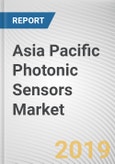Based on technology, the market is segmented into biophotonic technology, fiber optic technology and laser technology. On the basis of applications, the market is categorized into homeland security, industrial process, transportation, military, factory automation, civil structures and others. To study the scenario with respect to countries in Asia-Pacific region, the market is segmented into China, Japan, India, South Korea, Australia and Rest of Asia (ROA). Many prominent players operate in the market, which include Baumer Holding AG, Omron Corporation, Samsung Electronics Co. Ltd, Banner Engineering Corp., Toshiba, Honeywell International Inc. and Mitsubishi Electric Corporation.
KEY BENEFITS
A thorough analysis of the current and future trends in Asia-Pacific photonic sensor market elucidates the imminent investment pockets in this region.
The report highlights the key factors that drive and impede the growth of the photonic sensor market
Country-wise analysis describes the current market scenario and highlights the potential of photonic sensor market
Quantitative analysis of the current market and forecast through 20152020 are provided to showcase the financial appetency of the market in various countries of Asia-Pacific
Value chain analysis in the report provides a clear understanding on the roles of stakeholders in the market
Porters five forces model is used to analyze the potency of the buyers and suppliers, along with a detailed study on the market competition
PHOTONIC SENSORS MARKET KEY SEGMENTS
The Asia-Pacific photonic sensor market is segmented on the basis of technology, application and country.
BY TECHNOLOGY
Fiber optic technology
Laser technology
Biophotonic technology
BY APPLICATION
Homeland security
Industrial process
Transportation
Military
Factory automation
Civil structures
Bio and environmental analytics
Wind energy turbines
Mass transportation market
Airport security
Port security
Biomedical
Micro fluidic
Oil and gas
BY COUNTRY
China
India
Japan
South Korea
Australia
Rest of Asia (ROA)
KEY PLAYERS
Baumer Holding AG
Omron Corporation
Samsung Electronics Co. Ltd
Banner Engineering Corp.
Toshiba
Honeywell International Inc.
Mitsubishi Electric Corporation
Fujifilm Corp.
Hamamatsu Photonics Kk
Truesense Imaging Inc.
Methodology
The analyst offers exhaustive research and analysis based on a wide variety of factual inputs, which largely include interviews with industry participants, reliable statistics, and regional intelligence. The in-house industry experts play an instrumental role in designing analytic tools and models, tailored to the requirements of a particular industry segment. The primary research efforts include reaching out participants through mail, tele-conversations, referrals, professional networks, and face-to-face interactions.
They are also in professional corporate relations with various companies that allow them greater flexibility for reaching out to industry participants and commentators for interviews and discussions.
They also refer to a broad array of industry sources for their secondary research, which typically include; however, not limited to:
- Company SEC filings, annual reports, company websites, broker & financial reports, and investor presentations for competitive scenario and shape of the industry
- Scientific and technical writings for product information and related preemptions
- Regional government and statistical databases for macro analysis
- Authentic news articles and other related releases for market evaluation
- Internal and external proprietary databases, key market indicators, and relevant press releases for market estimates and forecast
Furthermore, the accuracy of the data will be analyzed and validated by conducting additional primaries with various industry experts and KOLs. They also provide robust post-sales support to clients.

LOADING...








